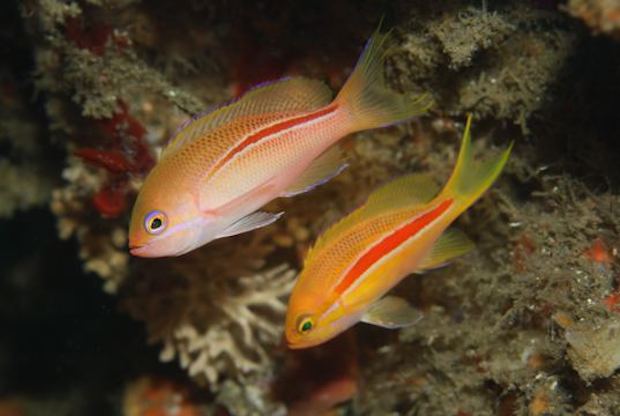Pseudanthias is such an exciting genus of fish dripping with so many incredible species and oozing with potential new discoveries that we find ourselves coming back to it repeatedly. With three subgenus currently known but rather poorly defined, it still poses a worthy and interesting subject for research and further studies. Since our last article on the new Pseudanthias cf. aurulentus from the Coral Sea, we’ve been conversing with Joe Rowlett on the possible phylogeny of the subgenus Microlabrichthys and he’s been proposing some fascinating hypotheses that we can hopefully share with you in the future.
With the exclusion of Microlabrichthys, the genus can be split into two more subgenera. They are Franzia and Pseudanthias. Franzia is the smallest subgenus which houses some of the evergreen aquarium staples such as Pseudanthias hutchii, P. squamipinnis (including all its geographical counterparts) and P. fasciatus.
Today’s topic of interest is geared towards Pseudanthias (Franzia) fasciatus, and it’s rarer lesser known sister, P. rubrolineatus.

P. fasciatus is a malt orange species that is moderately common in the aquarium trade, coming out of the Indo-Pacific. This medium to large species is characterised by possession of a unique red-stripe that runs equatorially along its length. The stripe is a continuation of an orange band that starts just behind the eye, but only intensifies into the characteristic red once it passes the pectoral fins. A cheek stripe is also present in this species.
P. fasciatus is a deepwater species that is found most often in or near caves and ledges at depths up to 150m (490ft). They’re typically found in loose groups and habitually orient their vents toward the steep contours of their catacomb habitat, often swimming upside down as well. Juveniles and females are more prominent in their red striped appearance, while terminal males may have it nondescript. In flashing males, the band may not even be present at all.

A second species bearing superficial resemblance resides in Japan, although it was first known from New Caledonia. It is Pseudanthias rubrolineatus, and apart from P. fasciatus, it cannot be confused for any other species.
Meristics aside, P. rubrolineatus can be differentiated from P. fasciatus by having a different stripe pattern. In P. rubrolineatus, the red stripe originates just slightly above the pectoral fin base, gently curving upwards before running anteriodorsally and terminating at the upper portion of the caudal peduncle. In both species, the red stripe is bordered by white on both margins, but the position as well as thickness of the stripe sets the two apart rather easily.
P. rubrolineatus is also unique in possessing filaments on both its caudal fin lobes. The number of filamentous extensions on each lobe can vary, but usually numbering three to five. To the best of our knowledge, this is the only species in the genus Pseudanthias to possess this unique tail morphology. These “fairy or thread tail” filaments are rarely seen in other Anthiinae species, but are most prevalent in Tosana, Tosanoides and at least one species of Odontanthias.

Like P. fasciatus, P. rubrolineatus is also deepwater and can be found at depths exceeding 200ft. At least in Japan, the two species are sympatric, and share their habitat with Sacura margaritacea and occasionally other Pseudanthias species like P. flavoguttatus and P. elongatus.
Like its sister, P. fasciatus loses the prominence of its stripe as it transits into its terminal phase. In large specimens, the stripe is usually incomplete and serves as a vestigial remnant of the former, sitting closer to the distal end of the fish. Terminal males in full display may not even show the slightest hint of this namesake characteristic.


Unfortunately, P. rubrolineatus is rare and very expensive in the trade. Only a handful of specimens have been offered for sale in Japan, and each costing a few grand. However seeing as this fish is so similar to P. fasciatus which costs only a mere fraction of that price, it doesn’t come across as that much of a heartbreaker.
It’s still nice to know that a parallel upper class version of our aquarium favourite lurks in the deep waters of Japan and New Caledonia. Where it probably sips champaign and fly private planes, occasionally stopping by to say hello.



